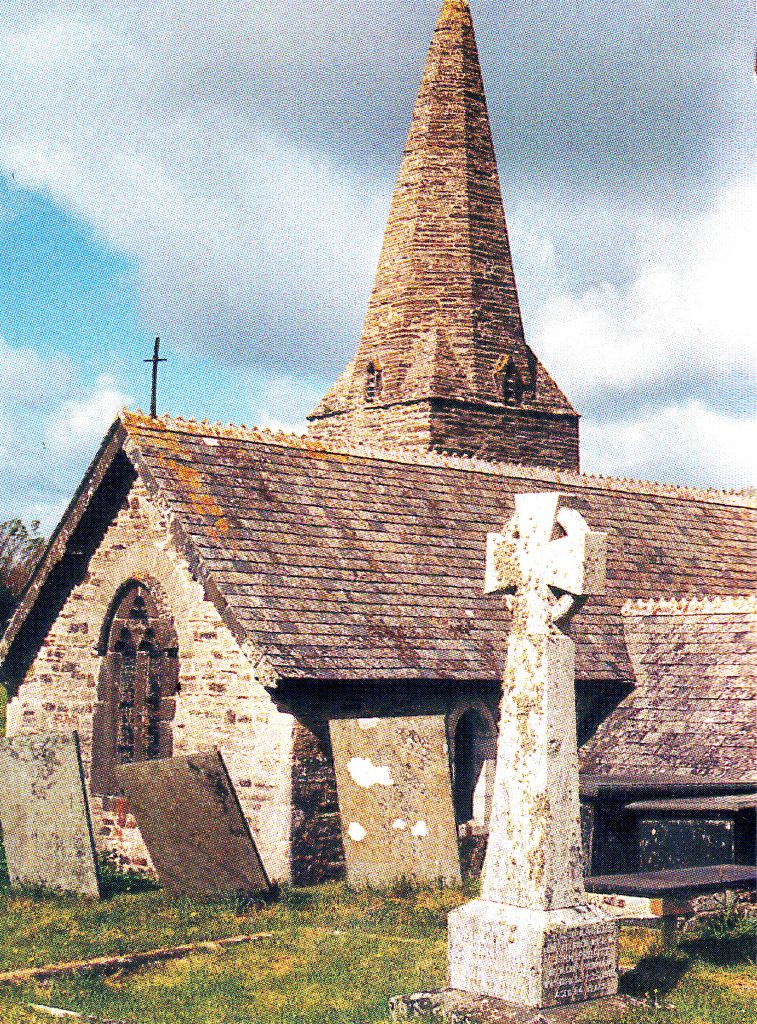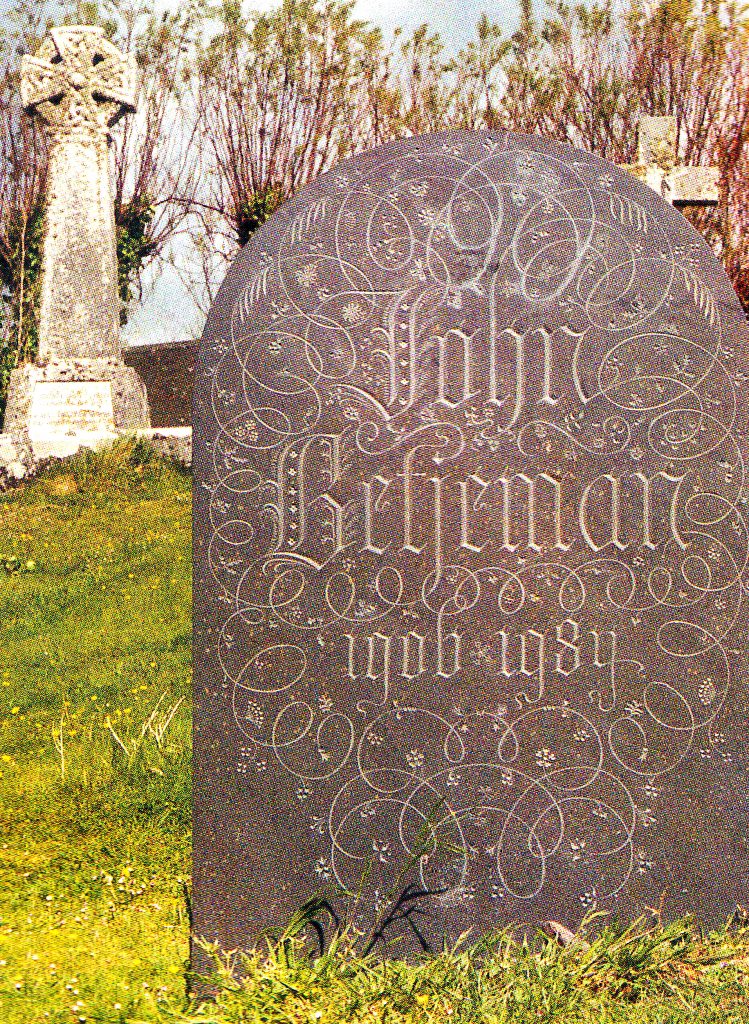This article featured in Cornwall Today, Yesterday & Dreckly in 1997
We have added the wonderful poem “Trebetherick by John Betjeman“
The original photos were taken by Terry Harry, they have for this articel been scanned from the printed magazine.
The teapot raised. I stopped and stared at the television screen. Apparently it was wet, windy and misty at Trebetherick, too. as the sad cortege wound its seemingly endless path to nowhere. The sandhills hid from view St Endoc’s church, but clear1y the long trek of the bearers was necessary, for no motor road was visible. How well the spirit of the dead would mingle with the mist, yet with what unmistakable clarity would he have pictured the scene for us had he been able to write it In the dogged, weather beaten faces of his bearers he would have seen the happenings and heredities that fashioned those expressions, and his written words would have etched them on our memories forever, for it was Sir John Betjeman they carried to his grave – the Poet Laureate of the “little things- and their impact on a lifespan. Suddenly the lychgate loomed up in the gloom of the screen.

From Collected Poems I remembered “Sea came flooding up the lane”. and from Beside the Seaside came “Ralph, Vasey, Alistair, Biddy, John and me”. I wondered if they had waded up the lane to follow him “home” on this day.
Our new home on Hannafore, West Looe, was still an unending joy to us each day as our balcony gazed across an expanse of sparkling blue water to the distant. curving arm of land ending in Rame Head. The incredible beauty of the Cornish coast kept opening up for us scenes beyond belief but now another one was on our discovery agenda! “Trebetherick?” said our neighbour. “Across the water from Padstow. You’ll not forget Daymer Bay in a hurry!”
How right he was, and of course we chose the weather! Golden sunshine, hedgerows a woven tapestry of wild roses and honeysuckle gently blowing in the sea breeze. From the car park we stepped straight down on to an endless expanse of golden sand and, even though the tide was low, quite large pleasure boats were sailing the narrow channel from Padstow to the open sea, laden with holidaymakers. At length we found the sunken lane a shaded tunnel formed by the ancient magnificent conifers fringing old, secluded gardens on either side.
The narrow wooden planks crossed a fast flowing stream, lost beneath us in a waving of meadowsweet and cow parsley, cocooned in overhanging branches of blossoming elder. The sights and smells of yesterday for us alone – or so it seemed! Then we were treading the narrow tracks through the sandy turf and marram grass, the golf course on our right. A tiny sign at our feet pointed the way up and over the dunes to the church and suddenly we too were passing through the ancient gateway to the churchyard. An enclosed space that seemed to flower like an oasis in spite of shifting sands. with St Enodoc’s church itself not dominating, but just nestling amid the gravestones as though God’s army of the faithful stood sentinel to protect it from all onslaughts. On a slope to the right of the lychgate, high enough to behold the magical sight of Daymer Bay, lay the real reason for our pilgrimage. The grass to the grave was worn by many feet. The headstone marked the years of his life. We mentally marked the differing periods of it and probed the sensitivities affecting each one of them.

Across the path his mother’s grave lay deep in wild flowers and an oval memorial plaque to his father adorned the right-hand wall as we entered the church. There was so much “family” here, so much of leisurely days and simple joys enshrined in the place. Sunday tea and evensong. brushed hair and freckled faces, serious in the kneeling thanks for joys untold. As his poem put it – “Ask for our children the happy days you gave”. The indestructible. grey strength of the crouching building- told of tenacity in face of storm and decay, though the broach spire is slightly out of the perpendicular. There are many reminders of Norman times. The font was founded buried in the floor when the chapel was restored in 1864. The carved chest behind it is mentioned in an inventory of 1613, at which time there were two bells in the tower. one inscribed “Alfredus Rex”. As King Alfred reigned from AD 871 to 899 it would seem that St Enodoc’s had a bell tower in those days while the open sea of Daymer Bay was in prehistoric times, a forest where wild animals roamed in their natural habitat. In 1857 a great gale shifted the sand and twelve feet below high-water mark, the stumps of oaks with horns of deer and other animals and yews were found together.
During the eighteenth and nineteenth centuries a finely-carved screen separating the nave from the chancel was unfortunately inexpertly cut away. the chapel then being in disrepair and almost completely buried in the sand. Local people called St Enodoc’s “sinkininny church. and as the sand encroached further, entry could be gained only through a roof of the north transept. By ecclesiastical law the vicar must enter the church at least once a year and it is thought that Bishop Phillpotts too entered that way on his visit in 1851 – an eerie experience, surely. Restoration took place in 1863 and 1864, by which time “the sands had blown higher than the eastern gable, the wet came in freely. The high pews were mouldy green and worm eaten and bats from the belfry flew everywhere”. The whole restoration cost £650 and to this day the many prayers inside its walls must surely bless the loving, sensitive hands that preserved so much so skilfully. The new roof shelters centuries of faith brought there by our forefathers, leaving behind a nimbus of hope to comfort the bowed heads of today. Recorded burials include many of unknown sailors whose ships were wrecked on Doom Bar while seeking refuge in the Camel Estuary. A shed by the hedge was used as a mortuary and no doubt Cornwall’s wild flowers spread their grace over it. Silently we said our goodbyes to St. Enodoc and to Sir John, turning our faces to the brilliance of Daymer Bay, grateful for the inspiration it provided for him. At this point, in this place, my mind rejected the prep school memories from his Summoned by Bells.
I turned back to gaze at the scene we had left and saw “tamarisks with light” – just as he had done.
Trebetherick by John Betjeman
We used to picnic where the thrift
Grew deep and tufted to the edge;
We saw the yellow foam flakes drift
In trembling sponges on the ledge
Below us, till the wind would lift
Them up the cliff and o’er the hedge.
Sand in the sandwiches, wasps in the tea,
Sun on our bathing dresses heavy with the wet,
Squelch of the bladder-wrack waiting for the sea,
Fleas around the tamarisk, an early cigarette.
From where the coastguard houses stood
One used to see below the hill,
The lichened branches of a wood
In summer silver cool and still;
And there the Shade of Evil could
Stretch out at us from Shilla Mill.
Thick with sloe and blackberry, uneven in the light,
Lonely round the hedge, the heavy meadow was remote,
The oldest part of Cornwall was the wood as black as night,
And the pheasant and the rabbit lay torn open at the throat.
But when a storm was at its height,
And feathery slate was black in rain,
And tamarisks were hung with light
And golden sand was brown again,
Spring tide and blizzard would unite
And sea come flooding up the lane.
Waves full of treasure then were roaring up the beach,
Ropes round our mackintoshes, waders warm and dry,
We waited for the wreckage to come swirling into reach,
Ralph, Vasey, Alistair, Biddy, John and I.
Then roller into roller curled
And thundered down the rocky bay,
And we were in a water world
Of rain and blizzard, sea and spray,
And one against the other hurled
We struggled round to Greenaway.
Blessйd be St Enodoc, blessйd be the wave,
Blessйd be the springy turf, we pray, pray to thee,
Ask for our children all happy days you gave
To Ralph, Vasey, Alistair, Biddy, John and me.